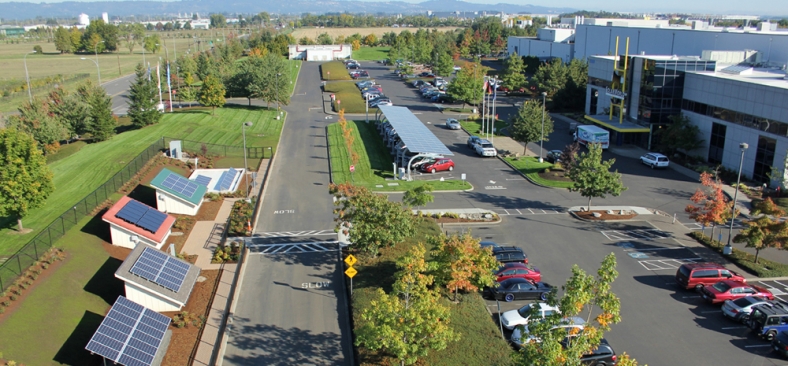Jan. 1, 2015
DC Fast Charging at the Workplace: SolarWorld
As the largest solar manufacturer in the U.S. and Europe, SolarWorld's commitment to sustainability is embedded in every aspect of its business and documented in its annual reports. In keeping with its climate protection goals, SolarWorld installed its first workplace charging station at its U.S. manufacturing headquarters in 2011. Its second station, a direct-current fast charger (DCFC) that allows vehicles to reach 80% charge in 20 minutes, was installed in 2014. Worldwide, SolarWorld has committed to reducing its company-wide greenhouse gas emissions 15% by 2020.
While most employers offering plug-in electric vehicle (PEV) charging install Level 1 or Level 2 charging stations, there are some cases where employers may want to consider installing DCFC. Level 1 and Level 2 charging can meet the needs of most employees that are parked during an average workday. During one hour of charging, Level 1 charging can replenish 2 to 5 miles of range and Level 2 charging can add about 10-20 miles of range. DCFC, which can quickly replenish a vehicle's battery, are another option for employers. The majority of DCFC on the market supply 50kW of power, which adds about 50 miles of range in 20 minutes. Lower power DCFC (24kW) are also available, which add about 24 miles of range in 20 minutes. Less than 2% of charging stations installed or planned by partners of the U.S. Department of Energy's Workplace Charging Challenge partners were DCFC, while nearly 79% were Level 2.
Potential Benefits of DCFC
Direct-current fast charging makes it possible for more employees to charge at a single station during the day. While only one or two PEVs can usually use a Level 1 or 2 charging station during normal work hours, many vehicles can use a DCFC throughout a day. Employers may use a DCFC as part of a strategy to alleviate charging congestion when there are more PEV drivers than Level 1 or 2 charging at a worksite.
DCFC can also be beneficial in emergencies or other situations when PEV drivers do not have time to charge at a Level 1 or 2 station and do not have sufficient energy to travel to their next destination. Challenge Partners have noted that the installation of DCFC is beneficial for employee-owned or fleet vehicles that are used frequently during the workday for offsite meetings.
DCFC Costs
It is important for employers to weigh DCFC's benefits with the cost considerations. Both the DCFC unit and the installation cost are significantly higher than Level 1 and 2 charging. DCFC units range in cost from $10,000-$40,000, depending on the power level and additional features. Installation costs can range from $4,000-$51,000, depending on how close the DCFC is to the electrical service and if there is sufficient electrical capacity for the DCFC's high power needs.
There may also be additional costs to permitting or additional municipal requirements for DCFC that do not exist for Level 1 or 2 chargers. While obtaining the permit for a DCFC, SolarWorld learned that Oregon's structural code required equipment that weighed more than 400 lbs be seismically restrained in the event of an earthquake. Since the DCFC weighed more than 400lbs, SolarWorld needed stamped engineering structural drawings for its concrete foundation. As engineering drawings typically cost $1,000-$3,000, the unexpected cost increased the project's budget.
Employers should also consider the potential impact on electric demand. DCFC can incur demand charges from $0 to more than $2,000, depending on the utility's rate structure and the site's peak power consumption. If a worksite is considering DCFC, the employer should talk with its utility about how much electrical capacity is available at the site and how DCFC will affect demand charges. When deciding whether DCFC is a good fit for your organization, work with your utility and an electrician for a site specific cost estimate.
DCFC Guidance for Employees of Visitors
Employers should consider developing a station usage policy to minimize demand charges and sharing guidelines. This can ensure that numerous employees have access to the DCFC when they need it. Clear access controls for the DCFC will help visitors and the general public know whether or not they may use the charging station. Since some PEV drivers may not be familiar with the process for using DCFC, additional signage can help ensure drivers properly use the equipment.

